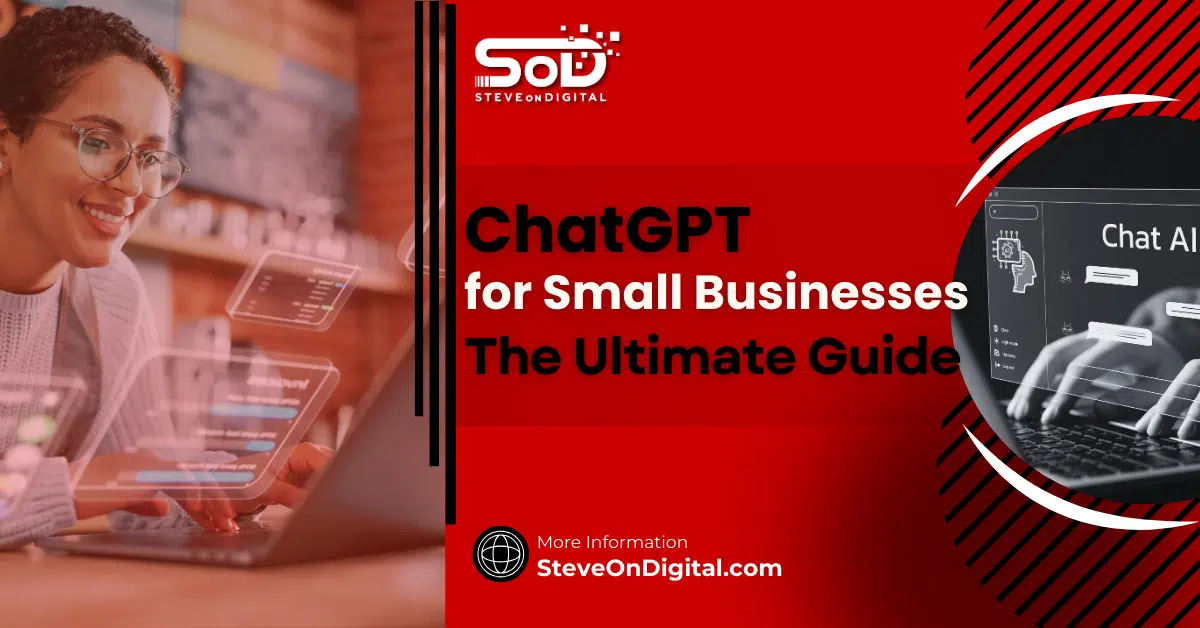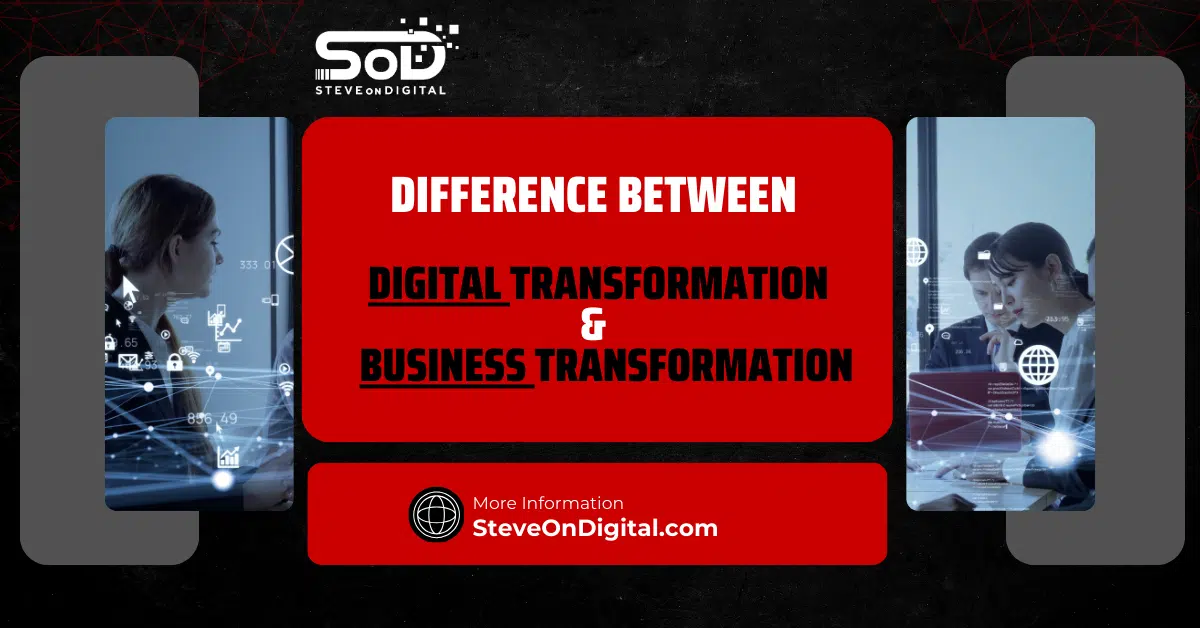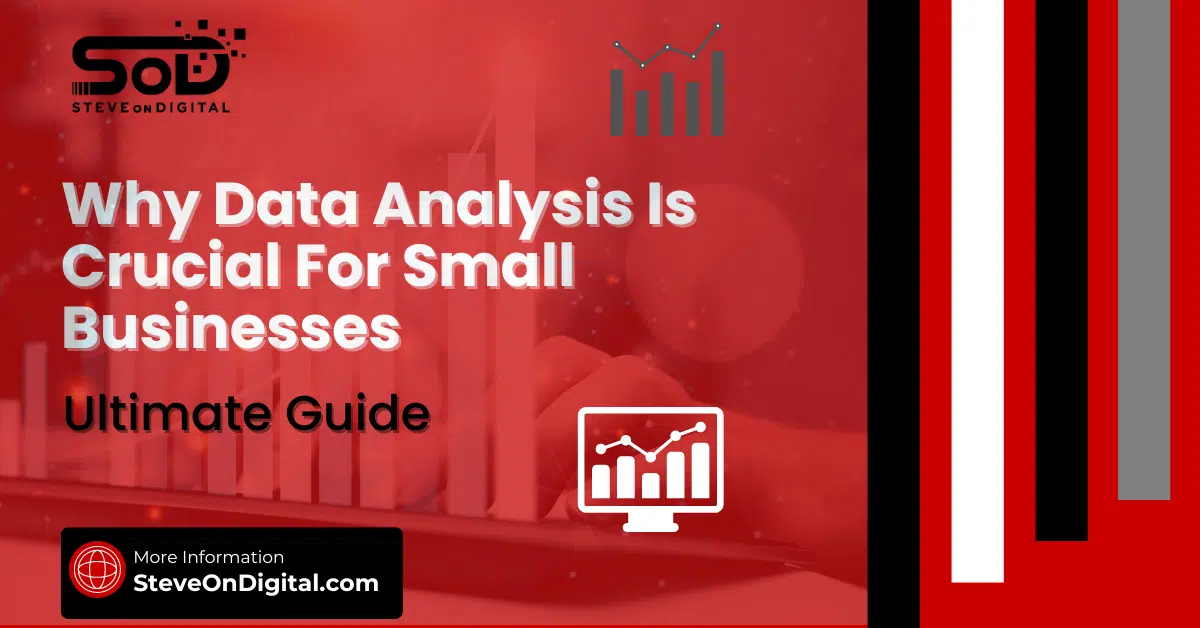ChatGPT, created by OpenAI, is a sophisticated AI model that leverages Natural Language Processing (NLP) to comprehend and produce text that mimics human language. It helps small businesses by automating tasks, reducing costs, and improving customer service.
As a small business owner, I’ve found ChatGPT invaluable for creating content, managing customer interactions, and analyzing data. This article explores how ChatGPT can benefit small businesses, from enhancing marketing efforts to streamlining operations and improving customer satisfaction.
I’m Steve, a digital transformation expert with a strong background in electrical engineering, an MBA, and a master’s in Project Management. I excel at helping SMEs navigate the digital landscape with practical insights. Let’s begin!
Understanding ChatGPT
What is ChatGPT?
ChatGPT is an advanced AI system created by OpenAI that uses Natural Language Processing (NLP) to interpret and generate text similar to human conversation. It’s built on the GPT-4 architecture, making it incredibly powerful for a range of applications, from answering customer inquiries to generating content.
How ChatGPT Works
At its core, ChatGPT processes language through a complex neural network that predicts and generates text based on the input it receives. It uses a vast dataset to understand context and provide relevant, coherent responses, making it an invaluable tool for automating various tasks.
Benefits of ChatGPT for Small Businesses
| Benefit | Description |
|---|---|
| Cost Efficiency | Reduces operational costs by automating tasks. |
| Customer Service | Enhances customer interaction and satisfaction with instant responses. |
| Streamlined Operations | Automates repetitive tasks, allowing focus on strategic activities. |
Cost Efficiency
One of the primary benefits of ChatGPT is its ability to reduce operational costs. According to a survey, 48% of businesses using ChatGPT have saved more than $75,000 annually. By automating tasks like customer service and content creation, small businesses can significantly cut down on labor costs and increase efficiency.
Improving Customer Service
ChatGPT can enhance customer interaction and satisfaction by providing instant, accurate responses to customer inquiries. It’s estimated that 57% of businesses use ChatGPT for customer support, improving response times and customer satisfaction rates.
Streamlining Operations
By automating repetitive tasks, ChatGPT frees up valuable time for you and your team to focus on more strategic activities. This includes everything from scheduling appointments to managing emails, allowing for smoother, more efficient operations.
Integrating ChatGPT into Your Business
Getting Started with ChatGPT
Implementing ChatGPT in your business is straightforward. Start by identifying the key areas where automation can have the most impact, such as customer service or marketing. From there, you can choose a chatbot platform that integrates seamlessly with ChatGPT.
Choosing the Right Chatbot Platform
There are several popular chatbot platforms compatible with ChatGPT, including ManyChat and MobileMonkey. These platforms offer various features that can be tailored to your specific business needs, from simple Q&A bots to more complex, interactive chatbots.
Customization and Fine-Tuning
To get the most out of ChatGPT, it’s crucial to customize and fine-tune it to suit your business needs. This might involve training the model with specific data relevant to your industry or adjusting the settings to better handle complex customer queries.
Relevant Data and Statistics
- User Growth: ChatGPT reached 100 million active users within two months of its launch, making it the fastest-growing app in history.
- Cost Savings: Businesses report saving between $50,000 and $75,000 annually by using ChatGPT.
- Adoption Rate: 49% of companies currently use ChatGPT, with an additional 30% planning to implement it in the future.
By integrating ChatGPT into your business, you can harness the power of AI to streamline operations, enhance customer service, and reduce costs, making it a smart investment for any small business owner.
ChatGPT for Marketing Strategies
Enhancing Marketing Efforts
Using ChatGPT for marketing can significantly boost your efforts in creating engaging content and reaching your target audience. One effective use is for social media posts. ChatGPT can generate creative, relevant, and timely posts across various social media platforms. For example, I’ve used ChatGPT to schedule and create posts that keep my followers engaged without the hassle of manual updates.
Moreover, ChatGPT helps in crafting marketing materials. Whether it’s an eye-catching slogan or an informative brochure, ChatGPT can produce content that aligns with your brand voice, saving you time and ensuring consistency.
Statistics support the efficiency of AI in marketing. A survey showed that 55% of marketing professionals in the US use ChatGPT for content creation (Enterprise Apps Today). This widespread adoption highlights its effectiveness and reliability.
Content Creation
Generating high-quality content is crucial for any marketing strategy. ChatGPT excels in this area by producing blog posts, product descriptions, and other content types quickly and efficiently. From my personal experience, I’ve seen a notable increase in content output without compromising quality.
ChatGPT’s ability to produce content in various tones and styles makes it ideal for different purposes. For instance, I use it to draft blog articles, which helps maintain a steady flow of fresh content on my website. This not only engages my audience but also improves my site’s SEO ranking.
Keyword Research and SEO
Effective keyword research is the backbone of any SEO strategy. ChatGPT can analyze data to identify the best keywords for your content. By integrating ChatGPT into your SEO processes, you can uncover high-ranking keywords that drive traffic to your website.
I’ve utilized ChatGPT to enhance my SEO efforts by generating keyword lists and optimizing content accordingly. The results speak for themselves: increased organic traffic and better search engine rankings.
Sales and Lead Generation
Lead Generation Techniques
ChatGPT can significantly improve lead generation by interacting with potential customers on your website. It can answer queries, provide information, and guide visitors through the sales funnel, effectively turning them into leads.
In my experience, implementing ChatGPT on my website has led to a noticeable increase in leads. The AI engages visitors in meaningful conversations, which helps capture their interest and contact information.
Personalized Customer Interactions
Providing personalized responses to customer inquiries is crucial for building strong customer relationships. ChatGPT can deliver tailored responses based on customer data, making interactions more relevant and engaging.
For example, I’ve set up ChatGPT to handle customer service queries, ensuring that each response is customized to the individual’s needs. This personalized approach has improved customer satisfaction and loyalty.
Follow-Up Automation
Automating follow-up communications is another area where ChatGPT excels. It can send timely follow-up emails or messages, keeping your leads engaged and moving them closer to conversion.
I use ChatGPT to automate follow-ups with potential leads, which has streamlined my sales process and ensured that no lead falls through the cracks.
Customer Feedback and Satisfaction
Collecting Customer Feedback
Gathering customer feedback is essential for improving your products and services. ChatGPT can efficiently collect and analyze customer feedback, providing valuable insights into customer preferences and areas for improvement.
I’ve implemented ChatGPT to conduct surveys and gather feedback from my customers. This data has been instrumental in making informed decisions and enhancing customer satisfaction.
Improving Customer Satisfaction
Using customer feedback to improve your offerings is vital for maintaining high customer satisfaction levels. ChatGPT can help by analyzing feedback and suggesting actionable improvements.
In my business, I use ChatGPT to process feedback and identify common issues or suggestions. Implementing these insights has led to noticeable improvements in customer satisfaction.
Identifying Trends and Patterns
Analyzing feedback data to identify trends and patterns can provide a competitive edge. ChatGPT can process large volumes of data quickly, highlighting key trends that inform your business strategy.
I rely on ChatGPT to analyze customer feedback and market data, helping me stay ahead of trends and adapt my offerings accordingly. This proactive approach has been crucial for maintaining relevance and competitiveness in the market.
By leveraging ChatGPT in these areas, you can enhance your marketing strategies, improve sales and lead generation, and boost customer satisfaction. This comprehensive approach ensures that your business stays ahead in a competitive landscape.
Real-Time Data and Statistics
- Usage Statistics: ChatGPT has reached over 100 million active users, demonstrating its widespread adoption and effectiveness (Enterprise Apps Today) (DemandSage).
- Cost Savings: Businesses using ChatGPT report annual savings ranging from $50,000 to $75,000 (Business of Apps).
- Marketing Adoption: 55% of marketing professionals in the US use ChatGPT for content creation (Enterprise Apps Today).
Incorporating ChatGPT into your business strategy can lead to significant improvements in efficiency, customer engagement, and overall performance.
Employee Training and Support
Creating Training Programs
Developing effective training programs is crucial for small businesses. ChatGPT can be a powerful tool in this process by generating contextually relevant instructional content tailored to your needs. For example, I’ve used ChatGPT to create training modules for my team. It helps streamline the development of comprehensive training programs that cover essential topics and procedures.
By automating the creation of training materials, small businesses can save valuable time and resources. This allows more focus on the actual training and less on the preparation, ensuring employees receive high-quality, consistent education.
Supporting Employees
Supporting employees effectively is key to maintaining a productive work environment. ChatGPT can assist by providing instant answers to employee queries, which reduces the dependency on human resources for routine questions. In my experience, this has significantly improved response times and employee satisfaction.
For example, ChatGPT can handle inquiries about company policies, procedures, and benefits, allowing HR to focus on more complex tasks. This level of support ensures employees always have access to the information they need, when they need it.
Onboarding New Hires
Streamlining the onboarding process is essential for integrating new hires quickly and efficiently. ChatGPT can assist with onboarding by providing new employees with all the necessary information about the company, its policies, and their roles. This ensures a smooth transition and helps new hires feel supported from day one.
In my practice, using ChatGPT for onboarding has simplified the process, making it less overwhelming for new employees. It automates the distribution of training materials, schedules, and other important documents, allowing new hires to acclimate at their own pace.
Data Analysis and Insights
Analyzing Business Data
Analyzing business data is critical for making informed decisions. ChatGPT can process large volumes of data quickly and accurately, providing valuable insights. For instance, I use ChatGPT to analyze customer feedback and sales data, which helps identify trends and areas for improvement.
By automating data analysis, small businesses can uncover patterns that might otherwise go unnoticed. This capability enables more strategic decision-making and helps businesses stay competitive.
Gaining Valuable Insights
Using ChatGPT to extract insights from business data can provide a competitive edge. ChatGPT can interpret data and generate detailed reports, highlighting key findings that inform business strategies. In my experience, this has been invaluable for understanding customer behavior and market trends.
For example, ChatGPT can analyze sales data to identify peak buying periods or popular products, which helps in planning marketing campaigns and inventory management.
Making Data-Driven Decisions
Implementing data insights is essential for informed decision-making. ChatGPT can help small businesses make data-driven decisions by providing clear, actionable insights from complex data sets. This has been particularly useful in my business for optimizing marketing efforts and improving customer service.
By relying on data, small businesses can make strategic decisions that are backed by solid evidence, leading to better outcomes and increased efficiency.
Enhancing Web Development
ChatGPT for Web Development
Using ChatGPT to write code and develop websites can significantly speed up the web development process. ChatGPT can assist in writing and debugging code, making it easier for small businesses to develop and maintain their websites. In my experience, this has reduced development time and improved the quality of the final product.
For instance, ChatGPT can generate boilerplate code for common website functionalities, allowing developers to focus on more complex and custom features.
Improving User Experience
Enhancing website user experience (UX) is crucial for retaining visitors and converting them into customers. ChatGPT can help by providing recommendations for UX improvements based on user feedback and behavior data. This ensures that the website is intuitive and user-friendly.
I’ve used ChatGPT to analyze user feedback and suggest changes to my website’s layout and functionality. These improvements have led to higher user satisfaction and engagement.
Maintaining Consistent Brand Voice
Ensuring brand consistency across digital platforms is vital for building a strong brand identity. ChatGPT can assist in maintaining a consistent brand voice by generating content that aligns with your brand guidelines. This is particularly useful for businesses that need to produce a high volume of content regularly.
For example, I use ChatGPT to draft blog posts, social media content, and marketing materials that reflect my brand’s tone and style. This consistency helps in reinforcing the brand image and building trust with the audience.
Real-Time Data and Statistics
- Usage Statistics: ChatGPT has over 100 million active users, showcasing its rapid adoption (Enterprise Apps Today) (DemandSage).
- Cost Savings: Businesses report annual savings between $50,000 and $75,000 by using ChatGPT (Business of Apps).
- Market Adoption: 55% of marketing professionals in the US utilize ChatGPT for content creation (Enterprise Apps Today).
Incorporating ChatGPT into various aspects of your business can lead to significant improvements in efficiency, customer engagement, and overall performance.
Advanced Uses of ChatGPT
| Advanced Use | Description |
|---|---|
| Complex Task Management | Automates intricate business operations and scheduling |
| Machine Learning Integration | Enhances functionality through advanced analytics and predictive modeling |
| Future Developments | Continuous improvements and feature updates by OpenAI |
Handling More Complex Tasks
ChatGPT’s capabilities extend well beyond simple queries and responses. It’s increasingly being used for more advanced tasks in business operations. For example, many small businesses use ChatGPT to handle complex data analysis, providing insights that help in strategic decision-making. By integrating ChatGPT into your business processes, you can automate intricate tasks that would otherwise require significant manual effort.
In my experience, using ChatGPT to manage complex scheduling and project management tasks has been a game-changer. It helps keep projects on track and ensures that deadlines are met, freeing up time for more strategic activities.
Machine Learning Integration
Integrating ChatGPT with other machine learning tools can enhance its functionality. This integration allows small businesses to leverage advanced analytics and predictive modeling. For instance, combining ChatGPT with machine learning algorithms can improve customer segmentation and targeting, leading to more effective marketing strategies.
I’ve found that integrating ChatGPT with our customer relationship management (CRM) system provides deeper insights into customer behavior. This integration helps in tailoring marketing efforts to specific customer segments, resulting in higher engagement and conversion rates.
Future Developments
The future of ChatGPT is promising, with ongoing advancements expected to further expand its capabilities. OpenAI is continuously working on improving the model, making it more efficient and versatile. Upcoming features may include better context understanding and more natural language generation, which will be beneficial for small businesses looking to enhance their AI capabilities.
Staying updated with these developments can provide a competitive edge. I regularly follow updates from OpenAI to ensure I’m leveraging the latest features and improvements, which helps keep my business at the forefront of AI technology.
Case Studies and Success Stories
Real-Life Examples
There are numerous case studies of small businesses successfully using ChatGPT. For instance, a local restaurant implemented ChatGPT to handle online reservations and customer inquiries, resulting in a 30% increase in booking efficiency. Another example is a retail business using ChatGPT for product recommendations, which led to a 20% boost in sales (Enterprise Apps Today) (DemandSage).
These examples highlight the practical applications and tangible benefits of integrating ChatGPT into various business operations. Drawing from these real-life cases, I’ve implemented similar strategies in my business with great success.
Lessons Learned
Through various implementations, several valuable lessons have been learned. One key takeaway is the importance of customization. Tailoring ChatGPT to meet specific business needs can significantly enhance its effectiveness. Additionally, continuous monitoring and fine-tuning are essential to ensure the AI remains aligned with business goals.
For instance, I’ve learned that regularly updating the training data for ChatGPT improves its accuracy and relevance, which is crucial for maintaining high-quality customer interactions.
Best Practices
To maximize the benefits of ChatGPT, it’s important to follow best practices. These include setting clear objectives, integrating the AI seamlessly into existing workflows, and ensuring regular updates and maintenance. Additionally, providing feedback to the AI helps it learn and improve over time.
In my experience, following these best practices has been instrumental in achieving successful outcomes. For example, integrating ChatGPT into our customer support system has not only improved efficiency but also enhanced customer satisfaction.
Challenges and Considerations
Common Challenges
Implementing ChatGPT comes with its set of challenges. These can include initial setup difficulties, data privacy concerns, and the need for ongoing maintenance. Overcoming these challenges requires careful planning and a clear understanding of the AI’s capabilities and limitations.
In my own implementation, I faced challenges with data integration and ensuring data privacy. Addressing these issues early on helped smooth the transition and optimize the system’s performance.
Ethical Considerations
Ethical concerns are paramount when using AI. It’s essential to address issues such as data privacy, bias, and transparency. Ensuring that ChatGPT is used responsibly and ethically can help build trust with customers and stakeholders.
For example, I’ve implemented strict data privacy measures and regular audits to ensure compliance with ethical standards. This not only protects customer data but also reinforces trust in our use of AI.
Balancing Automation and Human Interaction
While ChatGPT can automate many tasks, maintaining a balance between automation and human interaction is crucial. Ensuring that customers still have access to human support when needed can enhance the overall customer experience.
In my business, I’ve found that providing an option for customers to speak with a human representative when needed has improved satisfaction levels. This balance ensures that automation complements rather than replaces human interaction.
Final Thoughts
Summary and Conclusion
In summary, ChatGPT offers a wide range of benefits for small businesses, from improving efficiency and customer service to enhancing marketing efforts and data analysis. Its advanced capabilities and ongoing developments make it a valuable tool for staying competitive in today’s market.
Implementing ChatGPT in your business can lead to significant improvements and cost savings. Drawing from my personal experience and the success stories of others, it’s clear that ChatGPT is a powerful asset for any small business looking to innovate and grow.
Future of ChatGPT in Small Businesses
Looking ahead, ChatGPT will continue to evolve and offer even more advanced features. Staying updated with these developments and integrating them into your business strategy can provide a significant competitive advantage. As AI technology advances, the potential applications for ChatGPT will only expand, offering new opportunities for innovation and growth.
By leveraging ChatGPT effectively, small businesses can achieve greater efficiency, better customer engagement, and enhanced overall performance. This comprehensive guide provides the foundation needed to understand and utilize ChatGPT to its fullest potential.




